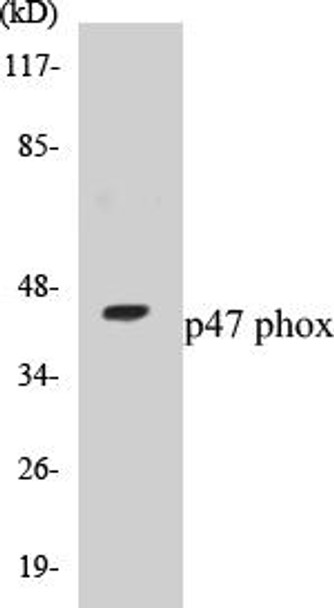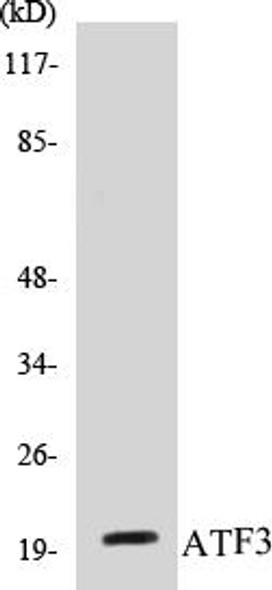Description
p47 phox Colorimetric Cell-Based ELISA Kit
The p47-phox Colorimetric Cell-Based ELISA Kit is a powerful tool for studying the p47-phox protein in cells. This kit allows for the accurate measurement of p47-phox levels in cell lysates, providing researchers with valuable insights into the role of p47-phox in various cellular processes.p47-phox is a key component of the NADPH oxidase complex, which plays a crucial role in the production of reactive oxygen species (ROS) in cells. Dysregulation of p47-phox and the NADPH oxidase complex has been implicated in a variety of diseases, including inflammatory disorders, neurodegenerative diseases, and cancer.
By using the p47-phox Colorimetric Cell-Based ELISA Kit, researchers can gain a better understanding of the function of p47-phox in their experimental model and uncover potential therapeutic targets for the treatment of p47-phox-related diseases. This kit offers high sensitivity and specificity, ensuring accurate and reliable results for a wide range of research applications.
| Product Name: | p47 phox Colorimetric Cell-Based ELISA |
| Product Code: | CBCAB00341 |
| ELISA Type: | Cell-Based |
| Target: | p47 phox |
| Reactivity: | Human |
| Dynamic Range: | > 5000 Cells |
| Detection Method: | Colorimetric 450 nmStorage/Stability:4°C/6 Months |
| Format: | 96-Well Microplate |
The p47 phox Colorimetric Cell-Based ELISA Kit is a convenient, lysate-free, high throughput and sensitive assay kit that can detect p47 phox protein expression profile in cells. The kit can be used for measuring the relative amounts of p47 phox in cultured cells as well as screening for the effects that various treatments, inhibitors (ie siRNA or chemicals), or activators have on p47 phox.
Qualitative determination of p47 phox concentration is achieved by an indirect ELISA format. In essence, p47 phox is captured by p47 phox-specific primary antibodies while the HRP-conjugated secondary antibodies bind the Fc region of the primary antibody. Through this binding, the HRP enzyme conjugated to the secondary antibody can catalyze a colorimetric reaction upon substrate addition. Due to the qualitative nature of the Cell-Based ELISA, multiple normalization methods are needed:
| 1. | A monoclonal antibody specific for human GAPDH is included to serve as an internal positive control in normalizing the target absorbance values. |
| 2. | Following the colorimetric measurement of HRP activity via substrate addition, the Crystal Violet whole-cell staining method may be used to determine cell density. After staining, the results can be analysed by normalizing the absorbance values to cell amounts, by which the plating difference can be adjusted. |
| Database Information: | Gene ID: 653361, UniProt ID: P14598, OMIM: 233700/608512, Unigene: Hs.647047/Hs.655201 |
| Gene Symbol: | NCF1 |
| Sub Type: | None |
| UniProt Protein Function: | p47phox: the 47-kilodalton cytosolic subunit of the multi-protein complex known as NADPH oxidase found in neutrophils. The holo-oxidase produces a burst of superoxide which is delivered to the lumen of the neutrophil phagosome. Contains 2 SH2 domains. Mutations in NCF1, as well as in other NADPH oxidase subunits, can result in chronic granulomatous disease. |
| UniProt Protein Details: | Protein type:Oxidoreductase; EC 1.-.-.- Chromosomal Location of Human Ortholog: 7q11.23 Cellular Component: cytosol; extrinsic to membrane; NADPH oxidase complex Molecular Function:electron carrier activity; phosphatidylinositol-3,4-bisphosphate binding; phosphoinositide binding; protein binding; SH3 domain binding; superoxide-generating NADPH oxidase activity Biological Process: antigen processing and presentation of exogenous peptide antigen via MHC class I; antigen processing and presentation of exogenous peptide antigen via MHC class I, TAP-dependent; antigen processing and presentation of peptide antigen via MHC class I; cell proliferation; cell redox homeostasis; cellular defense response; hydrogen peroxide biosynthetic process; inflammatory response; innate immune response; leukotriene metabolic process; negative regulation of smooth muscle contraction; protein targeting to membrane; respiratory burst; respiratory burst during defense response; response to yeast; small GTPase mediated signal transduction; superoxide metabolic process; superoxide release; vascular endothelial growth factor receptor signaling pathway Disease: Granulomatous Disease, Chronic, Autosomal Recessive, Cytochrome B-positive, Type I |
| NCBI Summary: | The protein encoded by this gene is a 47 kDa cytosolic subunit of neutrophil NADPH oxidase. This oxidase is a multicomponent enzyme that is activated to produce superoxide anion. Mutations in this gene have been associated with chronic granulomatous disease. [provided by RefSeq, Jul 2008] |
| UniProt Code: | P14598 |
| NCBI GenInfo Identifier: | 325511390 |
| NCBI Gene ID: | 653361 |
| NCBI Accession: | P14598.3 |
| UniProt Secondary Accession: | P14598,O43842, Q2PP07, Q53FR5, Q9BU90, Q9BXI7, Q9BXI8 Q9UDV9, Q9UMU2, A6NEH2, A8K7S9, |
| UniProt Related Accession: | P14598 |
| Molecular Weight: | |
| NCBI Full Name: | Neutrophil cytosol factor 1 |
| NCBI Synonym Full Names: | neutrophil cytosolic factor 1 |
| NCBI Official Symbol: | NCF1 |
| NCBI Official Synonym Symbols: | NCF1A; NOXO2; p47phox; SH3PXD1A |
| NCBI Protein Information: | neutrophil cytosol factor 1 |
| UniProt Protein Name: | Neutrophil cytosol factor 1 |
| UniProt Synonym Protein Names: | 47 kDa autosomal chronic granulomatous disease protein; 47 kDa neutrophil oxidase factor; NCF-47K; Neutrophil NADPH oxidase factor 1; Nox organizer 2; Nox-organizing protein 2; SH3 and PX domain-containing protein 1A; p47-phox |
| Protein Family: | Neutrophil cytosol factor |
| UniProt Gene Name: | NCF1 |
| UniProt Entry Name: | NCF1_HUMAN |
| Component | Quantity |
| 96-Well Cell Culture Clear-Bottom Microplate | 2 plates |
| 10X TBS | 24 mL |
| Quenching Buffer | 24 mL |
| Blocking Buffer | 50 mL |
| 15X Wash Buffer | 50 mL |
| Primary Antibody Diluent | 12 mL |
| 100x Anti-Phospho Target Antibody | 60 µL |
| 100x Anti-Target Antibody | 60 µL |
| Anti-GAPDH Antibody | 60 µL |
| HRP-Conjugated Anti-Rabbit IgG Antibody | 12 mL |
| HRP-Conjugated Anti-Mouse IgG Antibody | 12 mL |
| SDS Solution | 12 mL |
| Stop Solution | 24 mL |
| Ready-to-Use Substrate | 12 mL |
| Crystal Violet Solution | 12 mL |
| Adhesive Plate Seals | 2 seals |
The following materials and/or equipment are NOT provided in this kit but are necessary to successfully conduct the experiment:
- Microplate reader able to measure absorbance at 450 nm and/or 595 nm for Crystal Violet Cell Staining (Optional)
- Micropipettes with capability of measuring volumes ranging from 1 µL to 1 ml
- 37% formaldehyde (Sigma Cat# F-8775) or formaldehyde from other sources
- Squirt bottle, manifold dispenser, multichannel pipette reservoir or automated microplate washer
- Graph paper or computer software capable of generating or displaying logarithmic functions
- Absorbent papers or vacuum aspirator
- Test tubes or microfuge tubes capable of storing ≥1 ml
- Poly-L-Lysine (Sigma Cat# P4832 for suspension cells)
- Orbital shaker (optional)
- Deionized or sterile water
*Note: Protocols are specific to each batch/lot. For the correct instructions please follow the protocol included in your kit.
| Step | Procedure |
| 1. | Seed 200 µL of 20,000 adherent cells in culture medium in each well of a 96-well plate. The plates included in the kit are sterile and treated for cell culture. For suspension cells and loosely attached cells, coat the plates with 100 µL of 10 µg/ml Poly-L-Lysine (not included) to each well of a 96-well plate for 30 minutes at 37°C prior to adding cells. |
| 2. | Incubate the cells for overnight at 37°C, 5% CO2. |
| 3. | Treat the cells as desired. |
| 4. | Remove the cell culture medium and rinse with 200 µL of 1x TBS, twice. |
| 5. | Fix the cells by incubating with 100 µL of Fixing Solution for 20 minutes at room temperature. The 4% formaldehyde is used for adherent cells and 8% formaldehyde is used for suspension cells and loosely attached cells. |
| 6. | Remove the Fixing Solution and wash the plate 3 times with 200 µL 1x Wash Buffer for five minutes each time with gentle shaking on the orbital shaker. The plate can be stored at 4°C for a week. |
| 7. | Add 100 µL of Quenching Buffer and incubate for 20 minutes at room temperature. |
| 8. | Wash the plate 3 times with 1x Wash Buffer for 5 minutes each time. |
| 9. | Add 200 µL of Blocking Buffer and incubate for 1 hour at room temperature. |
| 10. | Wash 3 times with 200 µL of 1x Wash Buffer for 5 minutes each time. |
| 11. | Add 50 µL of 1x primary antibodies (Anti-p47 phox Antibody and/or Anti-GAPDH Antibody) to the corresponding wells, cover with Parafilm and incubate for 16 hours (overnight) at 4°C. If the target expression is known to be high, incubate for 2 hours at room temperature. |
| 12. | Wash 3 times with 200 µL of 1x Wash Buffer for 5 minutes each time. |
| 13. | Add 50 µL of 1x secondary antibodies (HRP-Conjugated AntiRabbit IgG Antibody or HRP-Conjugated Anti-Mouse IgG Antibody) to corresponding wells and incubate for 1.5 hours at room temperature. |
| 14. | Wash 3 times with 200 µL of 1x Wash Buffer for 5 minutes each time. |
| 15. | Add 50 µL of Ready-to-Use Substrate to each well and incubate for 30 minutes at room temperature in the dark. |
| 16. | Add 50 µL of Stop Solution to each well and read OD at 450 nm immediately using the microplate reader. |
(Additional Crystal Violet staining may be performed if desired – details of this may be found in the kit technical manual.)






